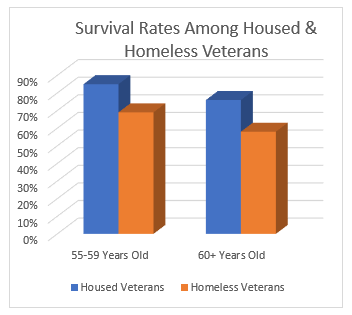Homeless Veterans
Bridging Housing and Healthcare
|
 |
Download PDF
INTRODUCTION
The Veterans Health Administration (VHA) serves a Veteran population that is increasingly diverse. Equitable access to high-quality care for all Veterans is a major tenet of the VA healthcare mission. The Office of Health Equity (OHE) champions the elimination of health disparities and achieving health equity for all Veterans.
OHE worked with the National Center on Homelessness Among Veterans (NCHAV) to bring attention to the older homeless Veterans population and the health disparities that exist among this group. NCHAV conducts and supports research; assesses the effectiveness of programs; identifies and disseminates best practices and integrates these practices into policies, programs, and services for homeless or at-risk Veterans.
There are 37,878 Veterans experiencing homelessness in the U.S. Unemployment, poverty, and lack of affordable housing are a few culprits that can leave a Veteran homeless. The majority (62%) of homeless Veterans are staying in sheltered locations. However, concerningly, 38% are staying in places not suitable for human habitation.
CHARACTERISTICS OF OLDER HOMELESS VETERANS
According to the National Center on Homelessness Among Veterans (NCHAV), 56% of homeless VHA users are aged 55 years or older. It is expected this population will continue to make up a large share of the overall pool of Veterans using VA homeless assistance programs well into the year 2025.
The U.S. Department of Housing and Urban Development’s Veterans Affairs Supportive Housing Program (HUD-VASH) is a collaborative effort to assist homeless Veterans find and sustain permanent housing. It accomplishes this by making housing affordable through HUD’s housing voucher program and by providing homeless Veterans with supportive services offered through the VA for health care, mental health treatment and substance use counseling. At the end of Fiscal Year (FY) 2018, there were 78,234 Veterans in housing with a HUD-VASH voucher.
REDUCING DISPARITIES AND IMPROVING ACCESS
Researchers suggest that project-based housing may help improve physical and behavioral health due to the social support and community engagement that is provided through programs such as HUD-VASH.
Mercy Housing’s Veterans Village located in Colma, CA is a 66-unit apartment building for formerly homeless Veterans. This housing project is a collaborative effort with the San Francisco Veterans Affairs Health Care System, Brilliant Corners, a nonprofit agency that serves Veterans and other individuals transitioning out of homelessness, and other local entities to provide an innovative approach on supportive housing. The housing unit has housing-based medical care and case management for 32 frail homeless Veterans 62 years old and older. The following wrap-around services are provided at Colma Veterans Village: health and wellness programming; recreational and educational activities; linkages and referrals to primary, preventative, and behavioral healthcare including access to onsite case management staff.
HUD-VASH case managers can also refer older homeless Veterans to population-tailored healthcare which has led to less use of acute care resulting in lower medical costs. The Homeless- Patient Aligned Care Team (HPACT) enhances coordination of care to better serve those with complex care needs. HPACTs are located on VA medical centers, community based outpatient clinics, and Community Resource and Referral Centers which increases access to health care and housing needs to one of VA’s most vulnerable population groups. The HPACT treatment model recognizes housing as a form of treatment for Veterans who are homeless or at risk. Stable housing can prevent illness and promote recovery.
For more information about the Office of Health Equity visit: https://www.va.gov/healthequity/ or on HPACT visit: https://www.va.gov/homeless/h_pact.asp.
For additional OHE fact sheets visit: https://www.va.gov/HEALTHEQUITY/Publications_and_Research.asp
OHE would like to extend a special thanks to Anne R. Fabiny, MD from VA’s Geriatric Services for guidance on local efforts for older homeless Veterans.
REFERENCES
Schinka, J., Bossarte, R., Curtiss, G., et al. (2015). Increased Mortality Among Older Veterans Admitted to VA Homelessness Programs [PMID: 26620292]
St. Pierre, C., McInness, K., et al. (2019). A Qualitative Perspective of Older Formerly Homeless Veterans in HUD-VASH Housing.




















